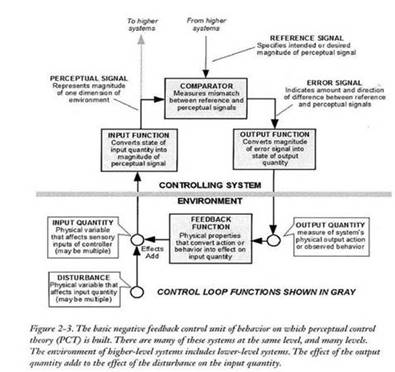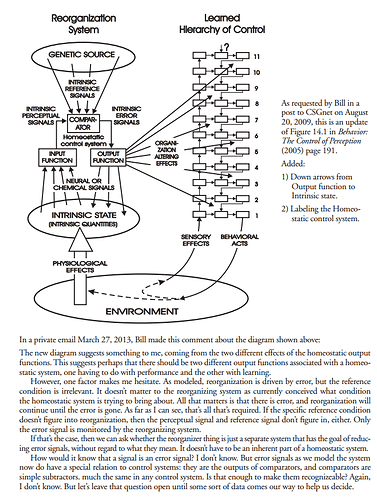Sorry I made a mistake in dialog in previous similar post so please consider it irrelevant and use this post for eventual answering.
Rick,
well I really don’t understand what’s wrong with Bills’ way of writing that you wouldn’t understand. I was already once angry on Barb and Bruce Nevin, because they wanted to show understanding of PCT as language problem. But in your case it’s obviously that it’s not problem the language you use for understanding what’s out there and how organisms function. It’s problem scientific knowledge and evidences that are used for understanding PCT.
You are repeating your RCT nonsense for years. And I answered you in the same way with Bills’ literature for I don’t how many times and you still don’t understand.
I admitt I needed some years to start understanding what Bill was saying to me and what he really wrote about, but it’s odd that somebody needs 40 years+ and still don’t understand what he wrote. All I want is that we would all participate in understanding great inventor. You are not helping. As we don’t have his word we just have to understand what he wrote. I know it’s hard to unify oppinions because every LCS perceive reality in a little bit diferent way according to “control and controlled content” in his hierarchy. But there must be the way how could we come to “equal” understanding what Bill wrote.
Again you are not using any evidences to support you RCT theory. It’s just because you think so (you imagine) and you think that the only right way are you perceptions of the “reality out there”. You are the only one who sees the “Real Reality”. I don’t know when you’ll understand that there are also other people perceving reality and that we have to find some consensus. Becasue some sciences are offering very strong evidences about how organisms function. That’s the final goal of PCT. Isn’t it ?
PCT is general theory about how organisms function. There are many theories which try to explain the same thing. I consider PCT to be the best. We just have to prove that to the world. But first we all have to understand what Bill really wrote about. You don’t seem to understand.
Rick you are making all the time at least one same mistake. You are generalizing from one experiment. What kind of science is that ? And other mistake is that you are using to much imagination instead of using some real evidences which could support your “imagination”.
I’ll do you a favour and I’ll repeat myself by copying and pasting what I already done for at least 30x. It seems that you don’t understand the basics of PCT. Your RCT theory is seriously deviating from PCT.
RCT (Ricks Control Theory) definition of control loop
-
CONTROL : Keeping of some »aspect of outer environment« in reference state, protected (defended) from disturbances.
-
OUTPUT FUNCTION : controlled effects (control of behavior) to outer environment so to keep some »controlled variable« in reference state
-
FEED-BACK FUNCTION : »Control« of some »aspect of outer environment« in reference state which is “cannonically controlled” along with “Control of perception”.
-
INPUT FUNCTION : produce »Controlled Perceptual Variable« or »Controlled Perception«, the perceptual correlate of »controlled q.i.«
-
COMPARATOR : ???
-
ERROR SIGNAL : ???
HB : Does this look like you understand PCT ?
PCT Definitions of control loop :
Bill P (B:CP):
- CONTROL : Achievement and maintenance of a preselected state in the controlling system, through actions on the environment that also cancel the effects of disturbances.
Bill P (B:CP):
- OUTPUT FUNCTION : The portion of a system that converts the magnitude or state of a signal inside the system into a corresponding set of effects on the immediate environment of the system
Bill P (LCS III):…the output function shown in it’s own box represents the means this system has for causing changes in it’s environment.
Bill P (LCS III):
- FEED-BACK FUNCTION : The box represents the set of physical laws, properties, arrangements, linkages, by which the action of this system feeds-back to affect its own input, the controlled variable. That’s what feed-back means : it’s an effect of a system’s output on it’s own input.
Bill P (B:CP) :
- INPUT FUNCTION : The portion of a system that receives signals or stimuli from outside the system, and generates a perceptual signal that is some function of the received signals or stimuli.
Bill P (B:CP) :
- COMPARATOR : The portion of control system that computes the magnitude and direction of mismatch between perceptual and reference signal.
Bill P (B:CP)
- ERROR : The discrepancy between a perceptual signal and a reference signal, which drives a control system’s output function. The discrepancy between a controlled quantity and it’s present reference level, which causes observable behavior.
Bill P (B:CP) :
- ERROR SIGNAL : A signal indicating the magnitude and direction of error.
Diagram (LCS III)
RM : ….since lay people (and apparently a good number ostensible PCT experts) tend to think of perception as just an imperfect representation of what is really “out there”.
HB : There are not just “ostensible” PCT experts (maybe you are the only one) that tend to think of perception as inmperfect representation of what is really our there, there are many other experts (like biologist, physiologists who proved with scientific evidences that perception is imperfect representation what is really out there. You are perfect evidences as your perception of Bills book is totaly imperfect representation of whta is out there. When your perception of Bills literature will becaome perfect ???
RM : I think a way to overcome this problem is to say that, according to PCT, we control various aspects of the world around us (which, in PCT, are called perceptions), …
HB : With what we control various aspects of the world arround us ? It’s definitelly not control of behavior !!! So what it is ???
Bill and Kent used term “stability” in outer environment instead of “control”,
Bill Powers to Phil Runkel :
First we must establish control as a phenomenon. This is not a theoretical matter. We have to show that organisms actually do stabilize external variables of all degrees of complexity against disturbances, maintaining them recognizably near reference conditions that we can identify experimentally. – William T. Powers
Kent M : The fact that the control of perceptions tends to stabilize variables in the physical environment provides a useful focus for analysis when we move from considering the actions of isolated individuals to talking about social interactions.
HB : I personally think that Bills’ and Kent’s statements and understanding what is out there use more suitable term (stability) to support Bills’ statements about not having direct knowledge of what we are doing to reality but still “the whole control loop” controls.
Bill P :
Our only view of the real world is our view of the neural signals that represent it inside our own brains. When we act to make a perception change to our more desireble state – when we make the perception of the glass change from »on the table« to »near the mouth« - we have no direct knowledge of what we are doing to the reality that is the origin of our neural signal; we know only the final result, how the result looks, feels, smells, sounds, tastes, and so forth…It means that we produce actions that alter the world of perception…
RM : …such as intensities (like loudness), sensations (like tastes), configurations (like shapes), relationships (like proximity), sequences (like melodies), etc. In other words, explain control of perception the way it is conceived of in the PCT model of purposeful behavior!
HB : In real organism this is not all. Hierarchy is still a problem to understand how it really works in organisms (diagram down), not just because there is a “question mark” on the top of it, but there are also some other misunderstandings.
I’m trying to explain for years, speccially to Powers ladies that PCT is not finished yet. We have to develope and upgrade it (and remove question mark), and the first step is finnishing diagram on p. 191 (B:CP, 2005) or improved version of that diagram which was done by Bill and it was exposed by Dug.
How would it know that a signal is an error signal ? I don’t know. But error signals as we model the system now do have a special relation to control systems: they are ouputs of comparators, and comparators are simple subtractors, much the same in any control system. Is that enough to make them recognazible? Again, I don’t know. But let leave that question open until some sort of data comes our way to help us decide.
HB : We see that the whole hierarchy has a problem about comparators, which are main part of hierarchy. And there are some other problems which will be seen more clearly with detailed analysis of how organisms function.
Do we really have to wait that some data comes our way to help us ? How much time ? Decade, century ?
Or it’s better that we start working and ???
Boris
Best
Rick

···
If nobody read what Bill wrote on the end of diagram down, it says this : Bill P (diagram down) :
Regards,
Fred Nickols
Managing Partner
Distance Consulting LLC
“Assistance at A Distance”
–
Richard S. Marken
"Perfection is achieved not when you have nothing more to add, but when you
have nothing left to take away.”
–Antoine de Saint-Exupery
